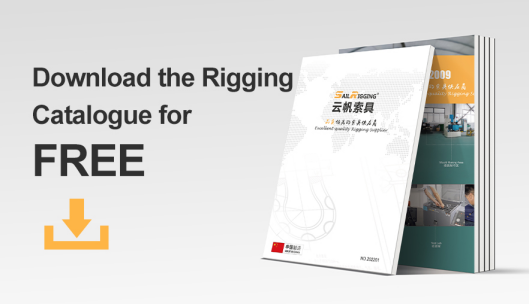DIN582 Eye Nuts, threaded eye nut, ring nut, are the formal designation based on the German industrial standard, has a loop or hole, play a vital role in rigging and lifting application. There’re so many eye nut, such as DIN582 eye nut, JIS1169 eye nut, G400 eye nut. Today, we will talk about DIN582 eye nut.
The DIN 582 eye nut is a key component in the rigging hardware world, offering a versatile and reliable solution for securing ropes, cables, or chains to a fixed point. With its distinctive eye shape and strong construction, the DIN 582 eye nut is commonly used in lifting, hoisting, and other heavy-duty applications. In this article, we will explore the characteristics of the DIN 582 eye nut, including its alternative names, surface finishes, sizes, and shapes.
Surface Finishes of DIN 582 Eye Nuts
The surface finish of a DIN 582 eye nut is crucial for enhancing its durability and corrosion resistance, especially in outdoor or marine environments. The most common surface finishes include:
Plain Steel (Raw Steel): These eye nuts are made from untreated steel, offering a solid, cost-effective option for indoor or dry environments where corrosion is less of a concern.
Zinc Plated: Usually there’re 2 type of Zinc Plating, white Zinc and yellow zinc plating. Zinc plating adds a protective coating to the eye nut, improving its resistance to rust and corrosion. This makes it suitable for outdoor applications, including in marine or industrial environments.
Hot-Dip Galvanized: For the highest level of corrosion resistance, eye nuts can be hot-dip galvanized. The process involves coating the eye nut with a thick layer of zinc to protect it from extreme environmental conditions, such as exposure to moisture, saltwater, or chemicals.
Stainless Steel: For the best corrosion resistance and strength, stainless steel is sometimes used to manufacture DIN 582 eye nuts. These eye nuts are ideal for use in highly corrosive environments, such as marine, food processing, or chemical industries.
Sizes and Dimensions of DIN 582 Eye Nuts
DIN 582 eye nuts come in a range of sizes to suit different load-bearing requirements. The size of the eye nut is generally determined by its thread size and the diameter of the eye loop. The typical size variations of the DIN 582 eye nut are:
Thread Sizes: DIN 582 eye nuts are commonly available in thread sizes ranging from M6 to M36 or even larger, depending on the load requirements. The thread size corresponds to the bolt or rod diameter onto which the eye nut will be screwed.
Eye Diameter: The diameter of the eye loop varies depending on the size of the nut, but it is generally designed to accommodate standard lifting tools such as hooks, shackles, or carabiners. Common diameters can range from 10 mm to 70 mm, or larger for more heavy-duty models.
Load Capacity: The load capacity of the eye nut depends on its size and material. For instance, smaller eye nuts (e.g., M6) might handle loads up to 1,000 kg (or 1 ton), while larger sizes (e.g., M36) can carry up to 30,000 kg or more, depending on the grade of material used.
The DIN 582 standard provides guidelines on the size and strength of eye nuts to ensure that they meet industry safety requirements and can handle expected loads without failure.
Shape of the DIN 582 Eye Nut
The shape of the DIN 582 eye nut is straightforward but crucial for its functionality. The main features of the eye nut’s shape include:
Eye Loop: The loop is the most defining characteristic of the eye nut. It is generally round or oval and is designed to accommodate a hook, shackle, or other rigging hardware for lifting and securing loads. The shape of the loop ensures that the load is evenly distributed and that the connection remains stable during use.
Threaded Body: The eye nut’s body is cylindrical with external threads on the inside, allowing it to be screwed onto a threaded bolt, rod, or structure. The length of the threaded portion may vary, but it is generally designed to ensure a secure and tight fit.
Flange (Optional): Some eye nuts come with a small flange around the base of the threaded portion, which helps distribute the load and prevent the nut from loosening over time. This is especially useful in heavy-duty applications.
Applications of DIN 582 Eye Nuts
DIN 582 eye nuts are used in a variety of industries and applications, particularly where a secure attachment point is needed for rigging, lifting, or securing objects. Some of the most common applications include:
- Lifting and Hoisting
As part of a lifting system, DIN 582 eye nuts are used to create anchor points for ropes, cables, or lifting hooks. They are commonly found in construction, warehouses, and industrial lifting operations.
- Marine and Shipping
Due to their ability to withstand harsh environmental conditions, zinc-plated and stainless steel DIN 582 eye nuts are commonly used in marine environments for securing loads, anchors, and mooring lines.
- Suspension Systems
In structural engineering and architecture, DIN 582 eye nuts are used in suspension systems, such as for canopies, tensioned cables, and supporting beams.
- Industrial Equipment
Eye nuts are also used to secure machinery and equipment to a fixed surface, ensuring that they remain stable and operational in industrial environments.
- Agricultural and Farming Applications
In agricultural settings, DIN 582 eye nuts are used to anchor various farm equipment, irrigation systems, and livestock handling equipment.
In a conclusion, DIN 582 eye nuts are versatile and indispensable component in the rigging and lifting industry. With its threaded design and looped eye, DIN582 eye nuts provide a reliable and strong point of attachment for lifting and securing heavy loads. Available in a variety of sizes, materials, and surface finishes, the DIN 582 eye nut can be customized for use in diverse industries, from construction and shipping to agricultural and industrial applications. If you have any question about eye bolt, please feel free to contact Sail Rigging.





